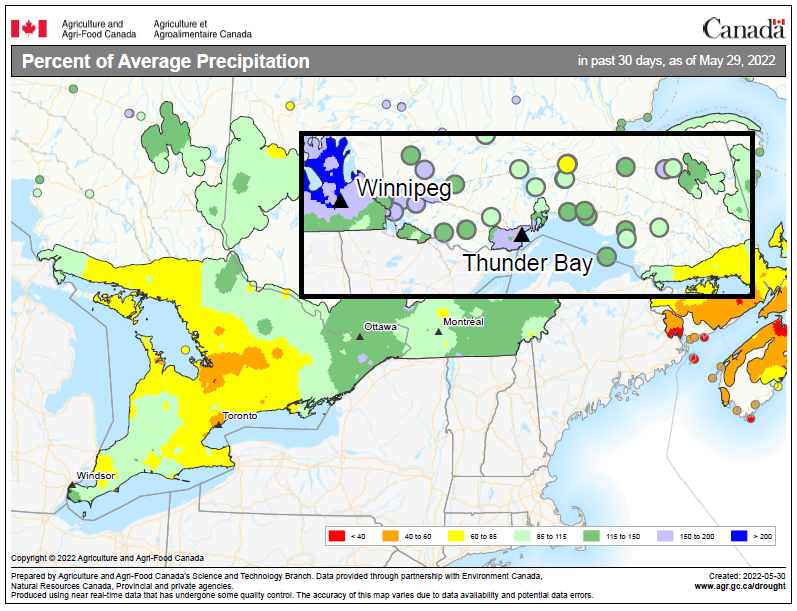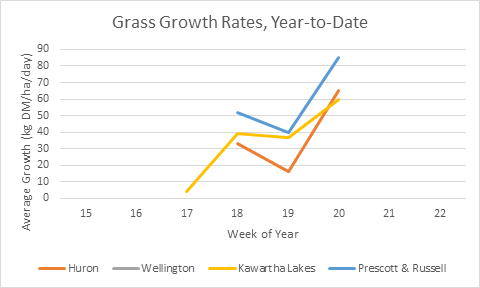Weather
- A derecho hit Ontario and Quebec along the Windsor-Québec City corridor on May 21st. High winds caused widespread power outages in central and eastern Ontario. Damage included downed/uprooted trees, snapped hydro poles, and several collapsed barns.
- Resources are available to help producers cope with stress and find mental health support.

South and West
- According to Agriculture and Agri-Food Canada: Huron, Perth, Middlesex, Oxford, and Elgin counties all had average precipitation for May. The rest of the region had less than normal rainfall.
- Tile-run alfalfa fields have been reported, with thin or dead patches between tiles and some problems with weed encroachment. Variable stem height and maturity has also been seen in these fields.
- 1st cut dairy harvest is slowly starting, about 1-2 weeks later than normal.
- Alfalfa weevil numbers are on the rise and could reach threshold before planned cutting dates. Information on scouting and managing alfalfa weevil is available here.
- Potato leafhoppers blow into Ontario on storm fronts. With the derecho bringing our first summer thunderstorms, it’s time to start scouting for potato leafhopper in alfalfa. Scouting information and thresholds can be found here.
Central and East
- According to Agriculture and Agri-Food Canada: Lennox & Addington, Frontenac, and Renfrew counties all received normal amounts of precipitation for May. Counties east of these had above-average precipitation, while counties to the west had less-than-normal rainfall.
- Winter cereal forage harvest is underway, with dairy-quality 1st cut expected to start shortly.
- Most forage crops were immature enough to avoid lodging from the derecho. Clean up of debris from the storm is ongoing. Debris must be removed from hay fields before first cut can begin.
- Potato leafhoppers blow into Ontario on storm fronts. With the derecho bringing our first summer thunderstorms, it’s time to start scouting for potato leafhopper in alfalfa. Scouting information and thresholds can be found here.
Northeast
- According to Agriculture and Agri-Food Canada: Manitoulin Island, Sudbury, and Parry Sound districts received below-average precipitation for May. Cochrane District had above-average rainfall. The rest of the districts in the northeast were in line with normal rainfall for May.
- Orchardgrass has headed out, and other species are beginning to head.
Northwest
- According to Agriculture and Agri-Food Canada, all three districts received above-average amounts of precipitation in May.
- Wet conditions have delayed field work and put additional pressure on already tight forage inventories. Details on how perennial forage species respond to excess water can be found here.
- On-off grazing is an alternative to using a sacrifice paddock in wet conditions that reduces or eliminates the use of stored forage while minimizing pugging damage.
- Alfalfa winterkill has been reported in Thunder Bay district.
- Resources are available to help producers cope with stress and find mental health support.
Pasture Production
Four pasture sites across Ontario are participating in a precision agriculture project to use grass more efficiently. Each week grass growth rates, among other production metrics, are measured using a rising plate meter. Average daily grass growth rates are shared publicly, while more detailed information is available to participating pasture managers.
Year-to-date grass growth rates are shown in Figure 2.

Many thanks to Living Lab – Ontario, Ontario Beef Research Centre – Elora, Victoria County Community Pasture, and la Ferme d’éducation et de recherche du Campus d’Alfred (FERCA) for their involvement in this project.